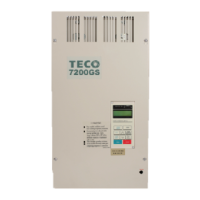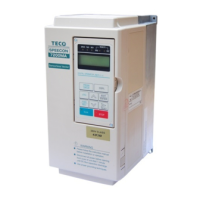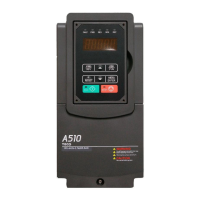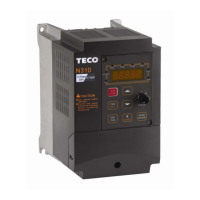44
4. FAULT DISPLAY AND TROUBLESHOOTING
The 7200GS/GS510 has protection function and warning self-diagnosis function. If a fault a occurs, the
protection functions operate to shut off the inverter output and the motor coasts to a stop, at the same time, the
fault contact signal (terminal R3A-R3C, R3B-R3C) is output.
A). PROTECTION FUNCTION AND TROUBLESHOOTING
Protection function Explanation LCD display (English)
Low
voltage
protection
Main circuit
low voltage
When the inverter power voltage drops, torque becomes insufficient and motor is
overheated.
Inverter output is stopped when the main circuit DC voltage becomes lower than
the low voltage detection level for 15 ms or longer. or about 2 seconds or longer if
the momentary power loss redo-thru function is used.
Detection level: Approximately 210V or less for 200V class
and 420V or less for 400V class
Fault (UV1)*
1
DC Volt. Low
Momentary
power loss
protection
Control circuit
low voltage
The inverter output is shut-off when he control circuit voltage drops below the low
voltage level.
Fault (UV2)*
Cont. Ckt Low Volt.
Man circuit
soft charge
contactor
The inverter output is shut-off when no answer back is received from the main
circuit soft-start contactor.
Fault (UV3)*
1
MC Ans. Fault
Overcurrent protection
The inverter output is shut-off when the inverter output current becomes approx.
200% and above of inverter rated current.
Fault (OC)*
1
Over Current
Ground-fault protection
The inverter output is shut-off when a ground-fault occurs at the inverter output
side and the ground-fault current exceeds approximately 50% of the inverter rated
current.
Fault (GF)*
1
Ground Short
Overvoltage protection
The inverter output is shut-off when the main circuit DC voltage becomes
excessive because or regeneration energy caused by motor deceleration and
negative load.
Detection. Approx. 800V for input voltage set 400V and above
Level : Approx. 700V for input voltage set 400V or less and approx. 400V for
200V class
Fault (OV)*
1
Over Voltage
Cooling fin overheat
The inverter output is shut-off when the ambient temperature rises and the heat
sink fin reaches 105℃. Please check for a detective cooling fan or clogged filter.
Fault (OH)*
1
Over Heat
Overload
protection
Motor
Inverter output is stopped when motor overload is detected by the electronic
thermal overload in the inverter. Either a inverter duty constant-torque specialized
motor or general-purpose motor can 9 selected. If more than one motor is driven.
overload protection should be disabled. Use a thermal relay or thermal protector for
each motor.
Fault (OL1)*
1
Motor Over Load
Inverter
The inverter output is shut-off when the electronic thermal overload reaches or
exceeds the inverse time limit of 103% of the inverter's rated current occurs.
Maximum rated overload: 110%. 1 min.
Fault (OL2)*
1
Inverter Over Load
Over torque
detection
The motor operates according to a preset mode when the inverter output current
execeeds the overtorque detection level. This function is used to protect the
machine or to monitor the output torque.
Fault (OL3)*
1
Over Torque
External
fault signal
input
Terminal ○
3
When an external alarm signal is input. the inverter operates according to a preset
stop method (coasting to a stop, continuous operation. or ramp to stop)
Fault (EF3)*
Terminal ○
5
Fault (EF5)*
Terminal ○
6
Fault (EF6)*
Terminal ○
7
Fault (EF7)*
Terminal ○
8
Fault (EF8)*
Control
Circuit
Fault
Control Circuit
The inverter output is shut-off when a transmission error occurs in the control
circuit or a component fails. The inverter output is also shut-off when a specialized
option such as the digital operator is not properly connected.
Fault (CPF02)*
EEPROM fault
Fault (CPF03)*
EEPROM
BCC CODE
Fault (CPF04)*
1
EEPROM CODE Err.
CPU ADC
Fault (CPF05)*
Option Card
Fault (CPF06)*

